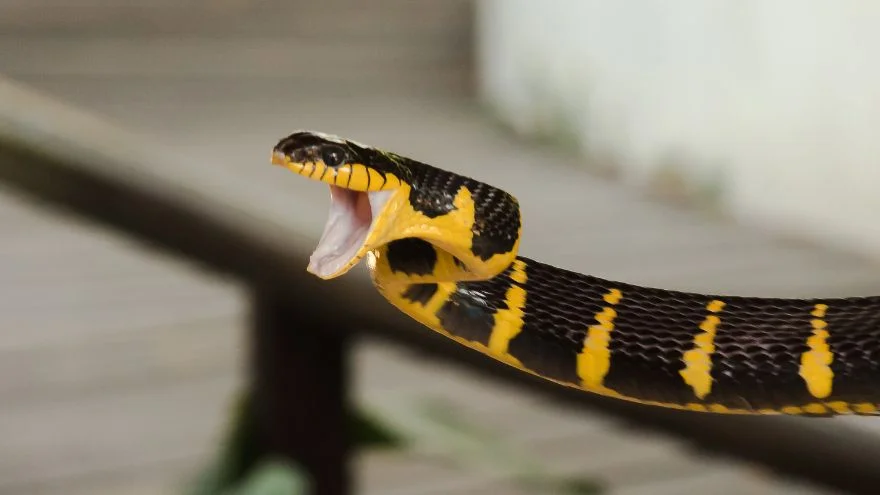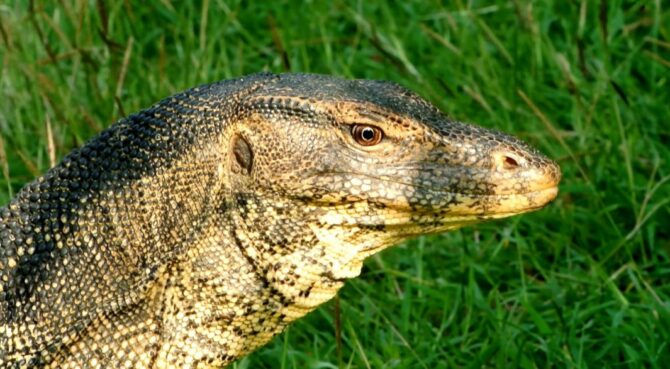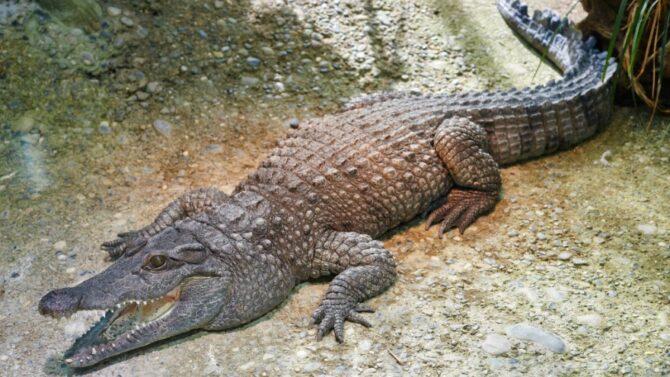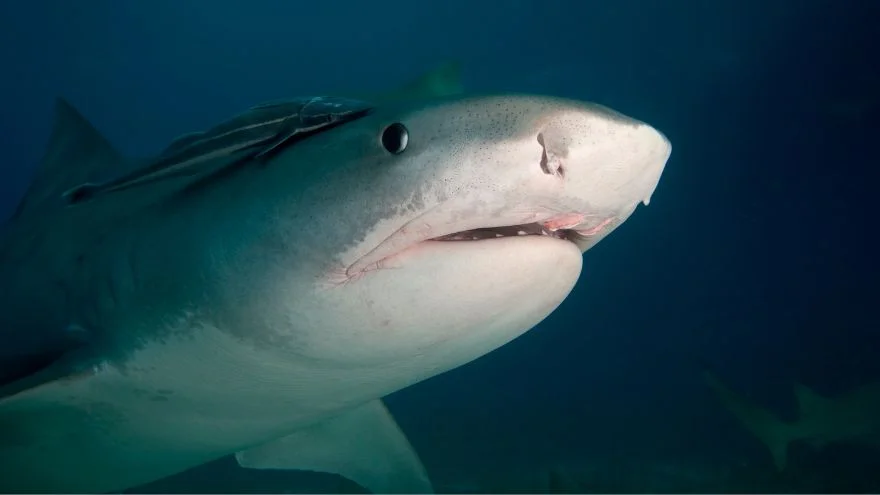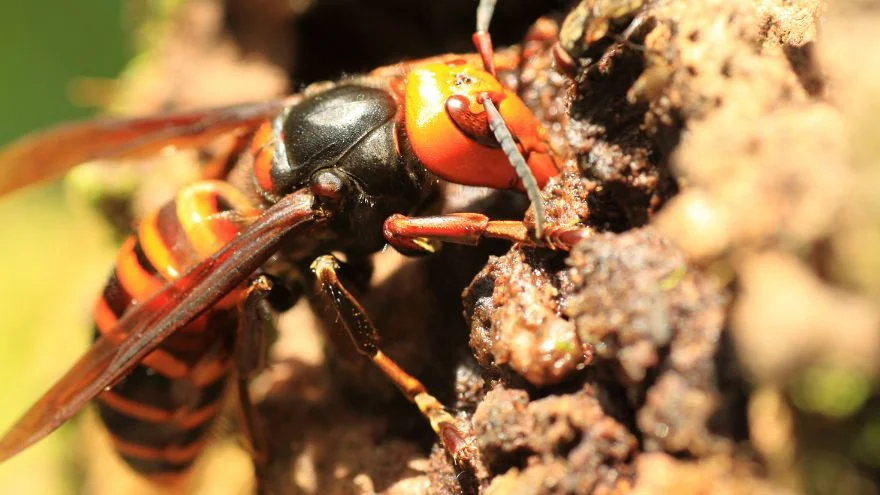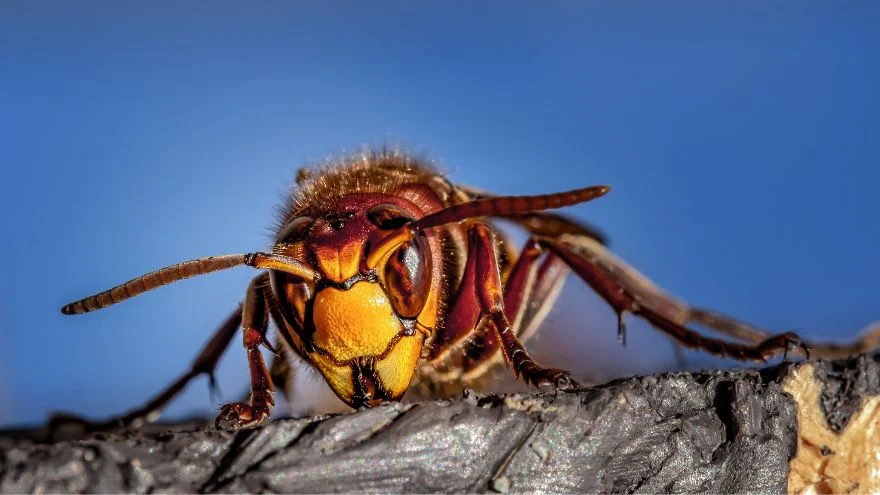Inside Thailand’s jungles, faunas, waters, and wetlands reside about 10% of all species of the world’s living organisms.
These include 2,800 species of fish, 300 species of mammals, 980 species of birds, and 490 species of reptiles and amphibians.
Some of the creatures in the Asian country are dangerous, and some are deadly; most do not attack out of the blue, but it is best to avoid them. The most dangerous animals in Thailand include snakes, monkeys, insects, fish, and sharks.
Therefore, we must discuss these deadliest animals in the Asian country.
What are the Most Dangerous Animals in Thailand?
1. Monocled Cobra

- Scientific Name: Naja kaouthia
- Classification: Reptile
- Habitat: Marshy fields, swamps, mangroves, grasslands, shrublands, forests
- Diet: Carnivore
- Conservation Status: Least Concern
Amongst all the things you would love to see in Thailand, you certainly do not want to encounter the monocled cobra. This cobra species is even more venomous than the Malayan krait.
Unfortunately, the monocled cobra is the most commonly-encountered deadly snake in Thailand’s capital, Bangkok.
This cobra species is very deadly, with a highly potent neurotoxic and cytotoxic venom. Unlike the shy and docile Malayan krait, the monocled cobra is fierce, striking at the slightest provocation.
You do not want to risk this snake’s bite as you might lose your life within an hour if a vein is affected.
The monocled cobra’s bite is usually characterized by respiratory or heart failure and has a high fatality rate.
2. Malayan Krait

- Scientific Name: Bungarus candidus
- Classification: Reptile
- Habitat: Moist forests and plantations, subtropical/tropical lowland forests
- Diet: Omnivore
- Conservation Status: Least Concern
Unfortunately, one of the world’s deadliest species is among Thailand’s commonest.
How deadly? The Malayan krait has an untreated mortality rate of 60–70% of humans.
While it has attractive blueish-black and white crossbands on the body and tail like the king snake, it is not the kind of snake to admire from close range or dare pick up.
However, the snake is shy and docile, preferring to mind its business except when it is cornered or provoked.
The Malayan krait’s venom is neurotoxic, attacking the nervous system. Therefore, a victim may experience headaches, nausea, stomach pain, vomiting, dizziness, and diarrhea.
It could advance to paralysis and convulsions without treatment and death within twelve to twenty-four hours without antivenom administration.
3. Bull Shark
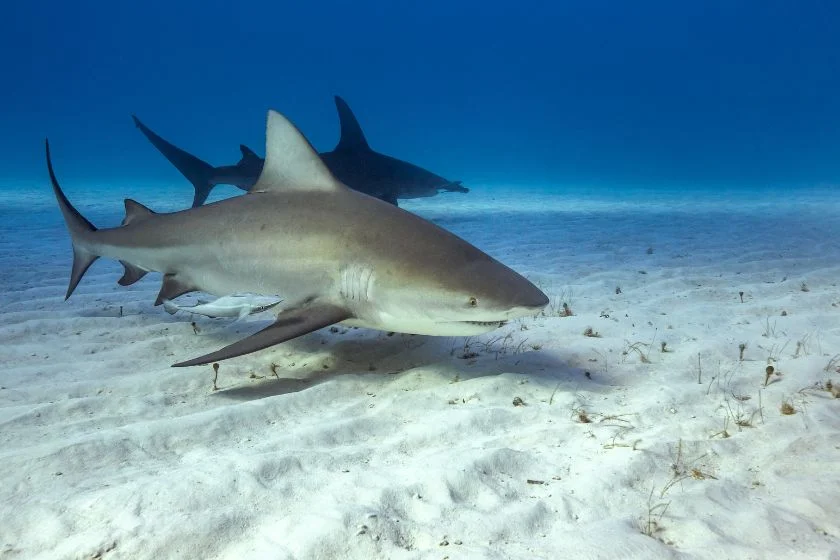
- Scientific Name: Carcharhinus leucas
- Classification: Fish
- Habitat: Estuaries, rivers
- Diet: Carnivore
- Conservation Status: Vulnerable
It was a black Tuesday for a Ukrainian father who witnessed his son’s horrific encounter with a giant shark on May 3, 2022, in Kamala Beach, Phuket.
The country’s Director of Marine Biology, Kongkiat Kittiwattawong, suspects the boy’s encounter was with a bull shark.
Similar shark attack incidents occurred in Thailand’s waters in 2020, 2018, 2015, and 2000.
The attack in 2020 was an encounter between a bull shark and a 75-year-old European tourist that ended in severe injuries for the human party.
Therefore, bull sharks are revered as one of Thailand’s most dangerous animals. As such, sharks have done enough to earn a fearsome reputation in the Southeast Asian country.
Bull sharks are enormous, reaching almost ten feet; they are notorious for their aggressiveness and migration ability.
The great white shark and tiger shark are ferocious too, but we are lucky not to find them in Thailand.
4. Rockfish

- Scientific Name: Sebastes norvegicus
- Classification: Actinopterygii
- Habitat: Rocky reefs, seafloors
- Diet: Carnivore
- Conservation Status: Not Extinct
If “rockfish” is easy on the ear, “scorpionfish” could be scary. Rockfish, also known as scorpionfish, exist in Thailand’s water coral reefs.
They are dangerous, with highly venomous spines, and it will be best to give them a wide berth.
Unfortunately, some rockfish species are artful masters of disguise, and spotting them might be challenging.
It would help if you were very cautious swimming in Thailand’s waters as schools of rockfish inhabit the Indo-Pacific region.
These beautiful sea creatures hunt smaller fish and crustaceans, paralyzing their prey with their highly potent venom.
Victims may feel numbness, swelling, bleeding, pain, tingling, and blistering; vomiting, shortness of breath, and seizures occur in extreme cases.
While fatalities are rare, it is possible. Please, make it a point never to swim at night as the rockfish are more active during this period.
5. Scorpions
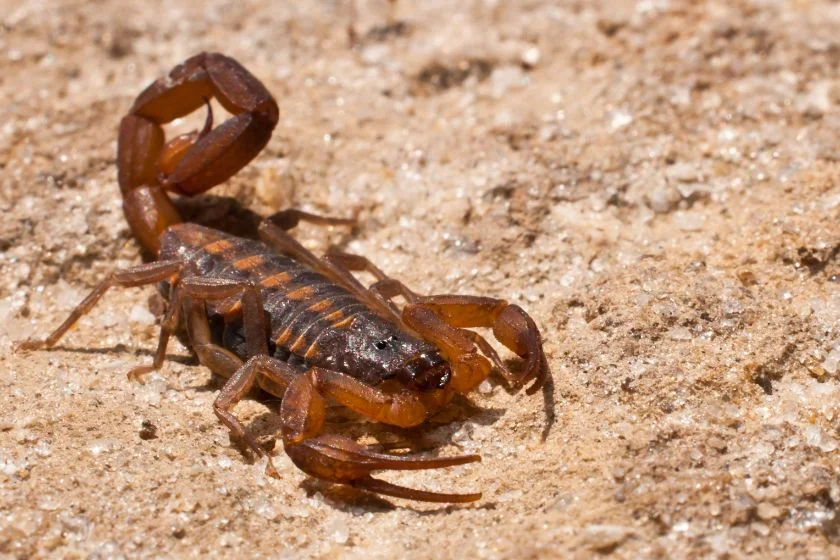
- Scientific Name: Scorpiones
- Classification: Arachnid
- Habitat: Tropical RainForest, grasslands, deserts
- Diet: Carnivore
- Conservation Status: Not Extinct
Eighteen species and subspecies of scorpions exist in Thailand and they are all venomous.
While most scorpions’ venom is mild, complications and possibly fatality may occur from allergic reactions to their venom.
Fortunately, unlike the rockfish, scorpions are easy to spot, even though you might find a scorpion more often than a rockfish.
Scorpions attack only when threatened and are nocturnal animals. It will help if you are extra careful at night, so you do not place a foot wrong and provoke a scorpion.
6. Box Jellyfish
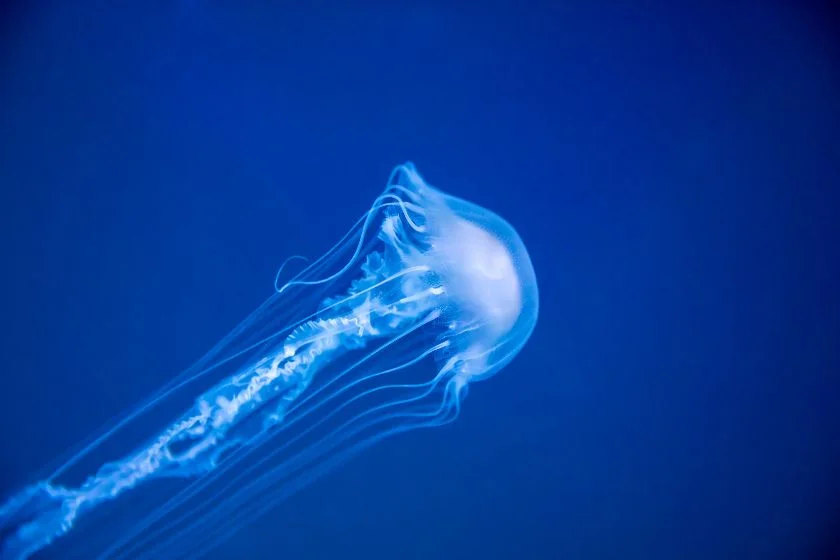
- Scientific Name: Chironex fleckeri
- Classification: Cubozoa
- Habitat: Tropical and subtropical seas
- Diet: Carnivore
- Conservation Status: Not Evaluated
Thailand has many dangerous animals inland, but Krabi, Phuket, Ko Lanta, and Phi Phi waters also contain some of the deadliest animals like the box jellyfish.
Reports of jellyfish stings in these areas make swimming risky as they are one of the world’s most venomous creatures.
The box jellyfish’s venom causes an over secretion of stress hormones, leading to high blood pressure or brain hemorrhage.
Its victims suffer from severe reactions, including cardiac arrest, paralysis, or death a few minutes after being stung.
7. Giant Desert Centipede

- Scientific Name: Scolopendra heros
- Classification: Chilopod
- Habitat: Underground, rocky woodland areas, damp foliages
- Diet: Carnivore
- Conservation Status: Not Evaluated
You can find the giant desert centipede throughout eastern Asia, including Thailand.
It is revered as one of Thailand’s most dangerous bugs, with an excruciating bite similar to a snake’s; little wonder they have a fearsome reputation among the locals.
Bruising and swelling are common symptoms, but difficulty breathing and rapid heartbeats can occur in extreme cases.
There are no recorded fatality cases, but the pain may last up to five days.
8. Red Lionfish
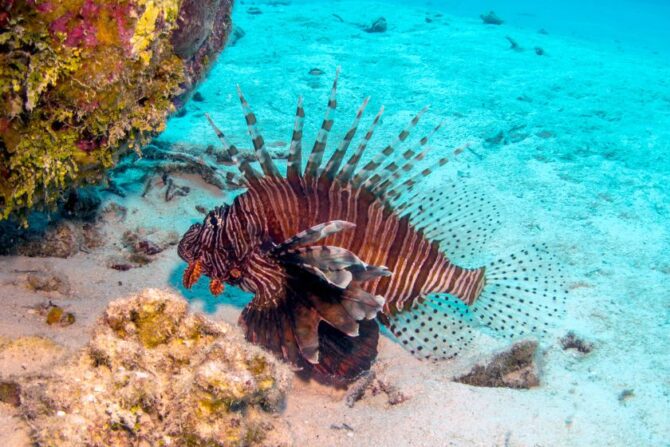
- Scientific Name: Pterois volitans
- Classification: Fish
- Habitat: Ocean
- Diet: Carnivore
- Conservation Status: Least Concern
The red lionfish is one of the world’s most dangerous fish species and is not shy to maintain that reputation if you fail to exercise caution around it.
Albeit its undeniable beauty, there is no other reason to come close to one of the largest lionfish species, not because of its size but its venomous spines.
A victim of a red lionfish’s sting may experience fever-like symptoms, extreme pain, diarrhea, headache, dizziness, and difficulty breathing. Fortunately, fatality is an uncommon occurrence.
9. Yellow Sac Spider
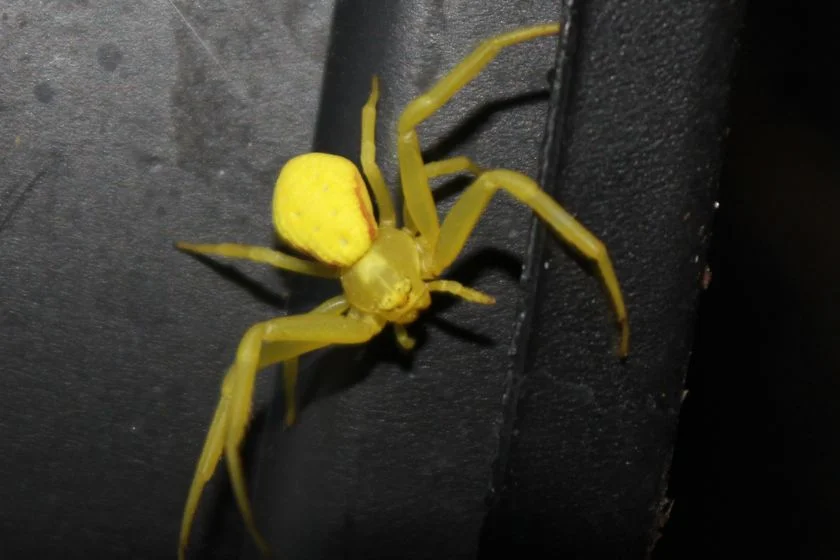
- Scientific Name: Cheiracanthium punctorium
- Classification: Arachnid
- Habitat: Gardens, foliage, wood, and debris
- Diet: Carnivore
- Conservation Status: Not Evaluated
There are between 700 and 1,200 spider species in Thailand, including fifteen unique species yet to be discovered in another country.
The yellow sac spider is one of the most popular species, earning its reputation for a massive yellow sac at the base of its body and a long-lasting, nasty bite.
A dose of venom follows the spider’s excruciating bite, causing pain and nausea.
Victims may suffer skin necrosis or anaphylactic shock in extreme cases.
10. Black Widow Spider

- Scientific Name: Latrodectus
- Classification: Arachnid
- Habitat: crevices, hollow logs, loose bark, holes, burrows, small trees, bushes, woodpiles
- Primary Diet: Carnivore
- Conservation Status: Not Evaluated
You can find the black widow spider anywhere in Thailand, especially in rural areas.
They prefer breeding and living where they can avoid every form of disturbance, so you are unlikely to find them in your house.
Their red, hourglass-shaped mark is attractive, but it is wise to admire them from a distance.
The black widow spider’s bite is often felt like a pin-prick, but the consequences have more negative impacts.
Their venom is neurotoxic, causing chest pain, muscle aches, nausea, muscle tightness, cramping, and a paralysis of the diaphragm, making breathing difficult.
Bites can be fatal but uncommon as only children, the elderly, or the infirm suffer complications.
11. Monkeys
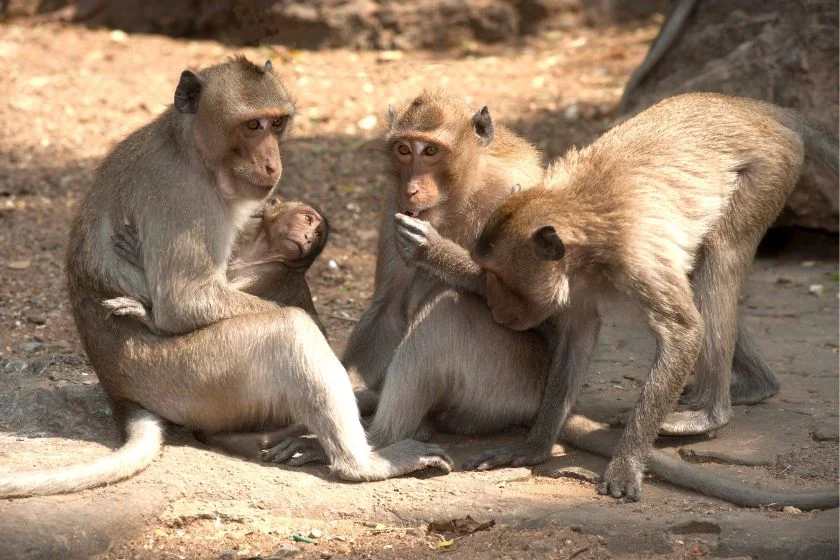
- Scientific Name: Macaca Fascicularis
- Classification: Mammal
- Habitat: Tropical rainforests, savannas, grasslands
- Diet: Herbivore
- Conservation Status: Least Concern
There are about 260 known monkey species in the world. While some can be domesticated, others are dangerous.
Thailand is home to many monkey species, including some wild ones.
You may think that monkeys are usually cute and friendly, but they make up for twenty percent of animal bites after dogs, especially among travelers.
The macaque is Thailand’s most prevalent monkey species. While these monkeys are not among the world’s largest, they attack and steal from Thai tourists.
They most likely will scratch or bite, but nursing mothers and mating pairs could be more ferocious.
Victims should visit a medical professional immediately to assess their wounds and receive proper medical attention.
12. Leeches
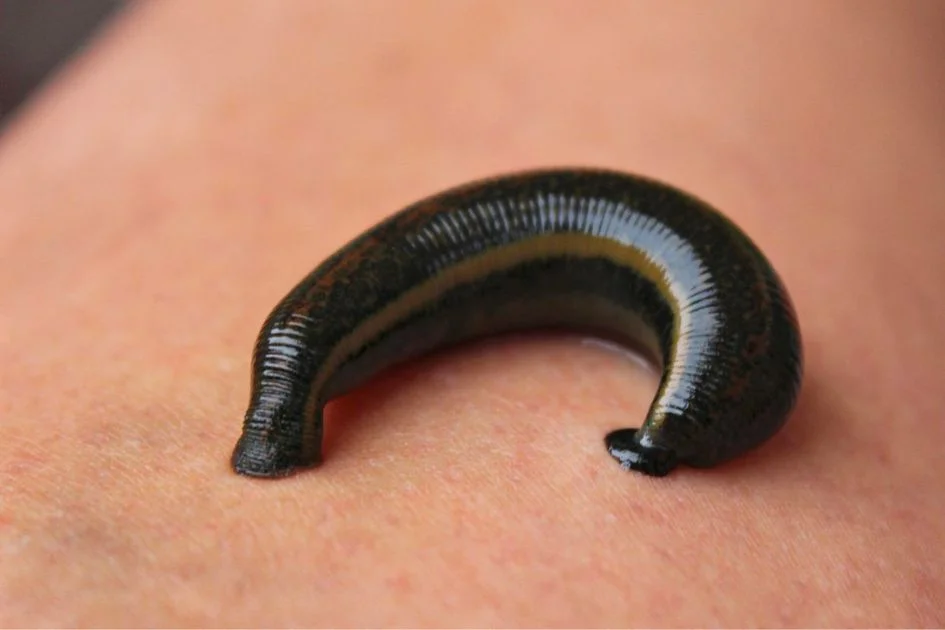
- Scientific Name: Hirudinea
- Classification: Clitellata
- Habitat: Freshwater, marsh, low foliage, rainforests, marine
- Diet: Carnivore
- Conservation Status: Least Concern
A journey through the Khao Sok National Park would not be complete without leeches attaching themselves to your skin.
Sadly, you will find them not only in Southern Thailand, where the Khao Sok National Park is located but in the sea waters and wet vegetation.
While scientists believe that leeches do not attack humans, they still pose a considerable danger to us as blood-sucking pests.
Large leech species have an excruciating blood-sucking process, using their tiny sharp teeth to open your skin and penetrating it with their lethal suckers.
13. Staphylinidae Beetles

- Scientific Name: Staphylinidae
- Classification: Insect
- Habitat: under debris, rocks, compost piles, decaying organic matter
- Diet: Carnivore
- Conservation Status: Not Evaluated
Staphylinidae beetles are a rove beetle species common in Thailand.
Rove beetles are notorious for their ‘paederin’ coelomic fluid that causes irritation and blisters on your skin.
While these battles do not sting, crushing them against your skin will cause their venomous body fluid to spread out, causing toxic damage to the skin and body cells.
You may feel itching, a burning sensation, burns, or see a red rash or purulent bumps on your skin. Worse still, the reaction may spread out to other parts of the skin.
Extreme cases may include vomiting, high fever, body pain, or headache. At the same time, the victim may become blind if it occurs in the eye.
14. Ants
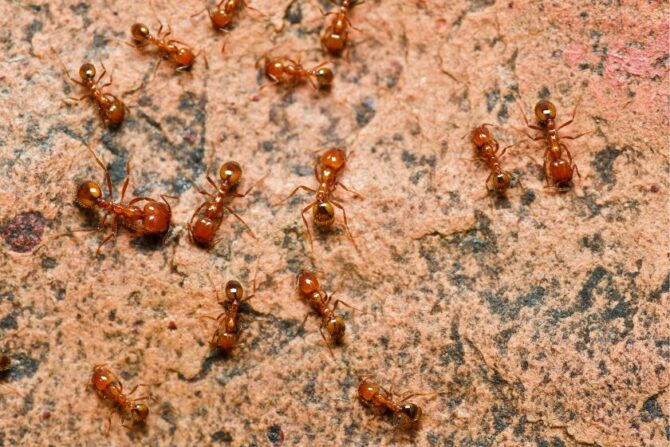
- Scientific Name: Formicidae
- Classification: Insect
- Habitat: Underground, ground-level mounds, wood structures, plants
- Diet: Omnivore
- Conservation Status: Not Extinct
There are thousands of ant species worldwide, with about eight hundred to a thousand living in Thailand.
Almost every specie looks harmless and undeniably small, but they can defend themselves like any other animal.
While most ant bites lead to no more than irritation and swelling, complications may occur from allergic reactions.
You may find it puzzling that the tiniest ants are the most dangerous, releasing allergens and poison upon biting.
15. Caterpillars
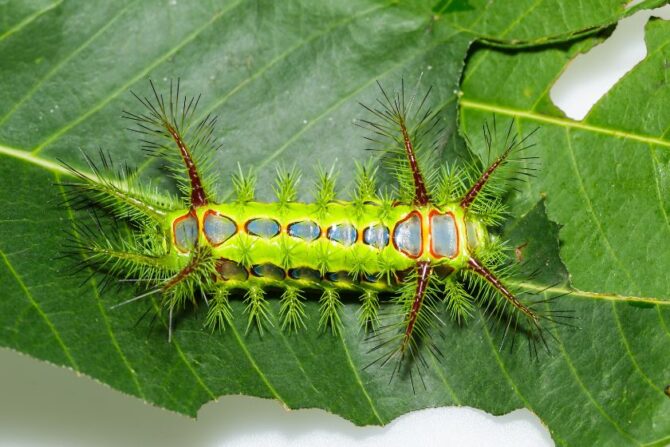
- Scientific Name: Rhopalocera (Butterfly); Gynnidomorpha alisman
- Classification: Insect
- Habitat: Quiet forests, pastures
- Diet: Herbivore
- Conservation Status: Least Concern
Like ants, among the world’s 20,000 caterpillar species, some of the most dangerous live in Thailand. An example is the stinging nettle caterpillar.
Even children learn that caterpillars metamorphosize to become moths or butterflies they know cannot sting.
Still, these larvae can hurt you even though they may look beautiful and harmless.
Their beautifully colored bodies are covered with tiny, venomous hair, which they eject into the surroundings.
You may experience irritation and some pain, while your smaller pets may experience fatal reactions by getting into contact with a caterpillar’s venomous hair.
Thailand Wildlife Safety Tips
Here are the dos and don’ts you must follow to protect yourself and the wildlife that occupies Thailand’s forests and seas.
Only swim in designated areas
Sharks occupy the Indo-Pacific region around Thailand, so it is wise to only swim in designated areas.
Some shark species in Thailand are aggressive toward humans, like the box shark. Reef shark attacks are rare but possible.
Therefore, it is wise to swim in designated areas around the shore, never out of the watch of lifeguards.
Wear a protective suit
Please remember that jellyfishes are transparent, making them difficult to see and avoid.
Therefore, wearing a protective suit while swimming is best because of jellyfish and rockfish.
You can get a skin suit or stinger suits made of thin, high-tech fabric and a pair of protective footwear as jellyfishes also sting humans wading in shallow waters.
Watch wildlife from a safe distance
It would be wise never to follow or approach wild animals due to their unpredictability and defensive instincts.
Wildlife may quickly feel concerned or threatened and, in their defense, harm people or themselves in an attempt to escape.
Stick to high visibility areas
It is best to stick to trails, avoiding grasses and overgrown places where snakes and other species can hide.
For instance, scorpions, the monocled cobra, and the Malayan krait are nocturnal snakes that hide around bushy areas during the day.
Wrap Up
An escapade into the supple assortment of flora and fauna, antique islands, thick rainforests, expansive national parks, first-class hiking trails, picturesque beaches, and incredible coral reefs explains why Thailand is the “Land of Smiles.”
While millions troop into the Asian country to bathe in its untamed natural beauty, we encourage you to stay safe.
Avoid these deadliest and most dangerous animals in Thailand, and apply our recommended wildlife safety tips to have the best Thai experience.
Discover The Most Dangerous Animals in Asia:
